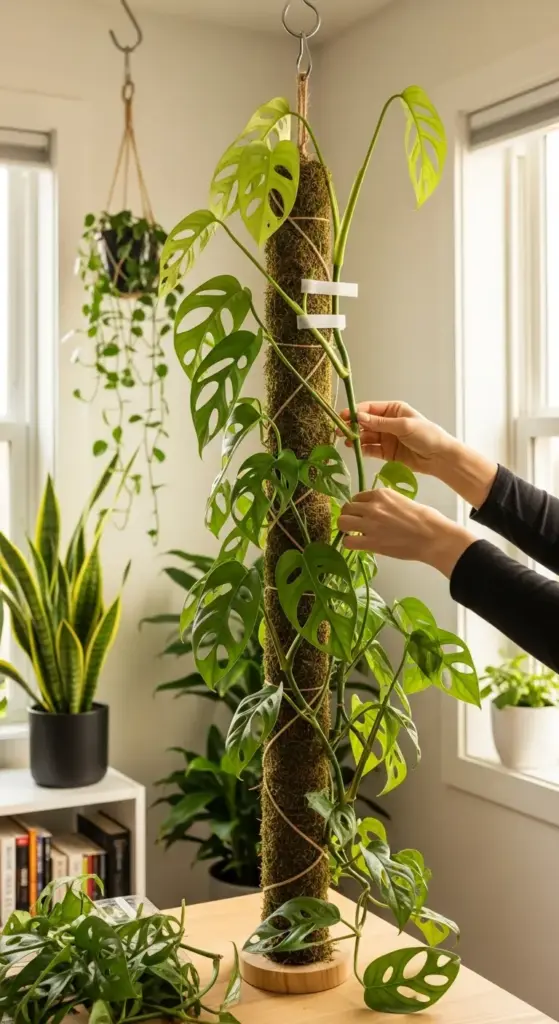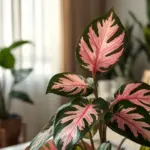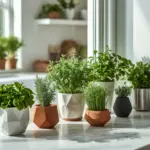6. Monstera Adansonii ‘Swiss Cheese Vine’

I bought my first Monstera Adansonii as a tiny 4-inch plant thinking it would stay cute and compact on my bookshelf. Six months later, it had completely taken over my living room corner and was reaching for the ceiling.
This plant has zero chill when it comes to growing.
But here’s the thing – once I learned how to work with its crazy growth habit instead of fighting it, it became one of my absolute favorite plants. Those fenestrated leaves are pure magic.
Training Techniques That Actually Look Intentional
The biggest mistake I made initially was letting my Swiss Cheese Vine just do whatever it wanted. It looked like a green explosion rather than an intentional design choice.
Training starts from day one, not after the plant gets out of control.
I use moss poles for my main plant, but here’s what nobody tells you – you need to actually tie the vine to the pole as it grows. It won’t just magically attach itself.
Soft plant ties or velcro strips work way better than wire or string that can cut into the stems. I check and adjust the ties every few weeks as the plant grows.
For hanging displays, I pinch the growing tips regularly to encourage bushier growth rather than one long, leggy vine. This creates that full, cascading look everyone wants.
The key is being consistent with training. I spend maybe 10 minutes every two weeks guiding new growth where I want it to go.
Support Systems That Don’t Look Like Plant Jail
I’ve tried every support system imaginable for my Monstera Adansonii, and most of them look terrible or don’t actually work long-term.
Bamboo stakes are cheap but they look cheap too.
Moss poles are my go-to for larger plants, but I wrap them in natural jute rope to make them look more intentional. The texture complements the organic leaf shapes perfectly.
For trailing displays, I use ceiling hooks rated for at least 20 pounds – these vines get heavy fast. I learned this when my first hanging setup crashed down at 2 AM.
Macrame hangers work beautifully if you want that boho vibe, but make sure they’re made with thick, quality cord. Those thin decorative ones will snap under the weight.
My favorite setup is a combination approach – moss pole for the main vine, with trailing sections cascading down from macrame hangers at different heights.
Pruning for Better Fenestration and Control
Here’s something that blew my mind when I first learned it – pruning actually encourages those gorgeous holes (fenestration) to develop faster.
The plant puts more energy into each remaining leaf when you remove excess growth.
I prune my Monstera Adansonii twice a year, usually in spring and mid-summer when growth is most active. I focus on removing any plain, non-fenestrated leaves first.
The golden rule: Always cut just above a node if you want new growth to branch from that point. Cut below a node if you want to stop growth in that direction.
Don’t throw away those cuttings! Every piece with a node can become a new plant. I’ve propagated probably 15 plants from my original one.
For size control, I trim back the longest vines by about a third. This keeps the plant manageable while encouraging bushier growth closer to the base.
Creative Small Space Solutions
Living in a tiny apartment taught me that Monstera Adansonii can actually work in small spaces if you get creative with vertical growing.
Think up, not out.
I’ve trained mine to grow up a tall, narrow moss pole in the corner of my bedroom. It takes up maybe 2 square feet of floor space but creates this gorgeous green column that draws the eye upward.
Wall-mounted trellises are another game-changer for small spaces. I use a simple wooden grid trellis and train the vines to weave through it, creating a living wall art piece.
Hanging from ceiling corners maximizes unused space while letting the vines cascade down naturally. Just make sure you have enough clearance for people to walk underneath.
For studio apartments, try using it as a natural room divider. Train it up a tall support and let some vines trail down to create privacy without blocking light.
Companion Planting That Actually Works
I used to think plant groupings were just about putting random plants together, but Monstera Adansonii taught me there’s actually strategy involved.
This vine pairs beautifully with upright plants that have different leaf textures.
My favorite combination is Swiss Cheese Vine trailing from a hanging planter with a Fiddle Leaf Fig or Snake Plant underneath. The contrast between the fenestrated trailing leaves and solid upright foliage is stunning.
For humidity lovers, I group mine with Calatheas and Ferns. They all benefit from the increased humidity created by grouping, and the different leaf shapes create visual interest.
Avoid pairing with other trailing plants unless you want your space to look like a jungle took over. One trailing element per grouping is usually plenty.
Color-wise, the bright green of Monstera Adansonii looks amazing with darker foliage plants like ZZ Plants or Rubber Trees. The contrast makes both plants look more vibrant.
I also love pairing it with plants that have similar care requirements – Pothos, Philodendrons, and other Monsteras all thrive in similar conditions, making maintenance way easier.
Want to add some serious elegance with a plant that literally moves throughout the day? Click “next” to discover the Calathea White Star – the prayer plant that’ll have your guests mesmerized by its daily leaf choreography!









GIPHY App Key not set. Please check settings